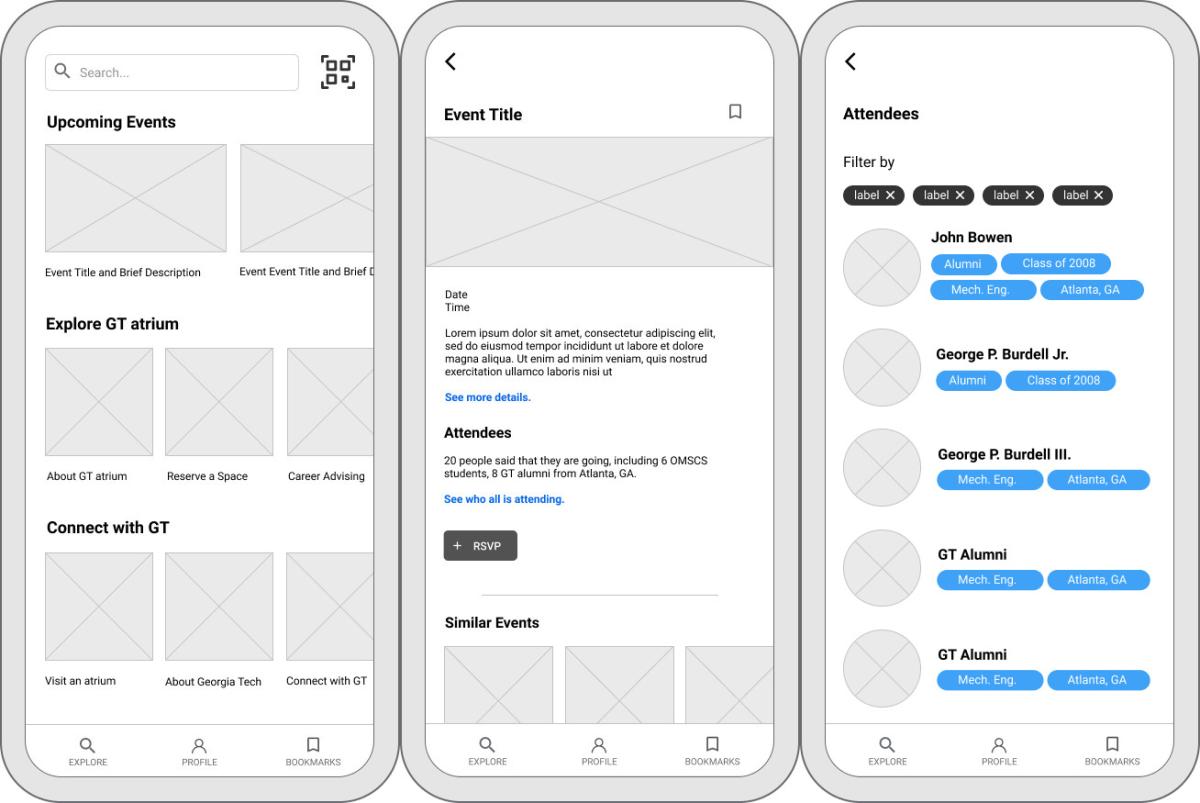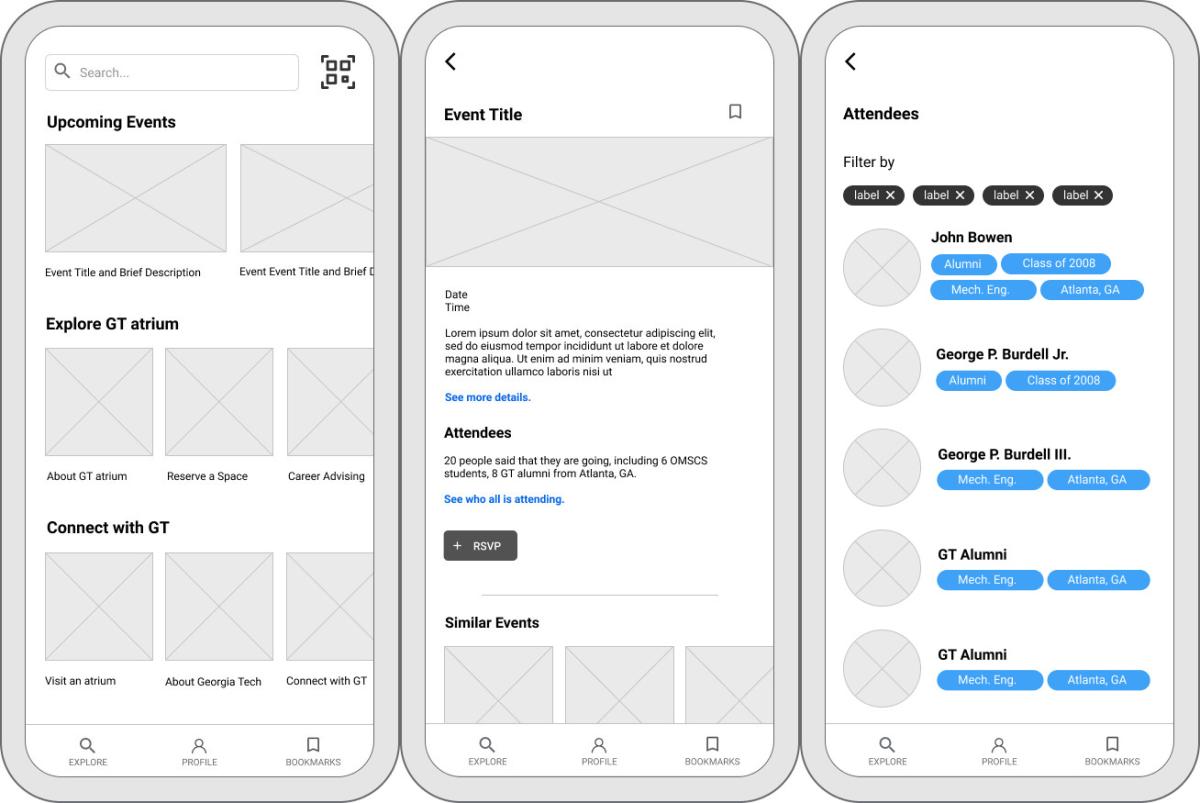This year, as C21U graduate research assistants, we were tasked with researching and designing initial concepts for a nascent but quickly-developing CNE project: the Georgia Tech atrium. As a physical gathering space and gateway to both in-person and digital GT services—such as career counseling, exploring GT credentials, and networking—the GTatrium™ is intended to expand the possibility for individuals to experience Georgia Tech beyond Atlanta. Alongside visiting atria, users will be able to extend their experiences using the GTatrium™ mobile application, weaving together their in-person and digital experiences, from near atria and afar.

This year, as C21U graduate research assistants, we were tasked with researching and designing initial concepts for a nascent but quickly-developing CNE project: the Georgia Tech atrium. As a physical gathering space and gateway to both in-person and digital GT services—such as career counseling, exploring GT credentials, and networking—the GTatrium™ is intended to expand the possibility for individuals to experience Georgia Tech beyond Atlanta. Alongside visiting atria, users will be able to extend their experiences using the GTatrium™ mobile application, weaving together their in-person and digital experiences, from near atria and afar.
Our goal was to define what the GTatrium™ experience would be like for visitors, which included defining the services and affordances of the space and the mobile application. Towards this end, we:
- Conducted primary research to understand the needs of potential atria visitors
- Designed and summarized the GTatrium™ experience using a user journey map
- Created low-fidelity prototypes for the mobile app
- Conducted initial user testing on these app prototypes
Because this space is intended to serve a wide range of groups (e.g. GT alumni, in-person students, distance learners, the local community), the first step was to understand the needs of these potential visitors, where these needs overlap, and how we might best serve their needs.
Research
We scoped our first phase of research to focus on Georgia Tech Online Master’s (OMS) students and alumni/mid-career professionals, and conducted 13 semi-structured, remote interviews. One key finding was that, although many users have ample opportunity to connect digitally with others—such as other OMS students, instructors, and other alumni—the GTatrium™ could provide both groups with opportunities for meaningful synchronous interactions, or what one interviewee described as “water cooler talk.” While this might sound trivial initially, many students mentioned that this was lacking in their current experiences, and that it can be a critical, but often overlooked step in building academic and professional relationships.
We also found that two key reasons many participants chose Georgia Tech’s distance learning option—flexibility of time and geographic location—might be at odds with their ability to visit atria, which would require both time and transportation. This has remained an important consideration as we continue to develop the GTatrium™ concept: how might we support potential atria visitors who have numerous time commitments, such as full-time jobs and familial obligations, in visiting a GTatrium™?
In our second phase of research, we sought to understand how the GTatrium™ might intersect and scaffold the goals of our potential collaborators and stakeholders. To do so, we conducted interviews with six individuals from a variety of Georgia Tech organizations: Georgia Tech Professional Education (GTPE), the Center for Education Integrating Science, Mathematics, and Computing (CEISMC), the online Master of Science in Computer Science (OMSCS), the online Master of Science in Analytics (OMSA), the Georgia Tech Alumni Association, and the Office of Industry Collaboration. We also conducted a competitive analysis to understand how other academic institutions and retail businesses (e.g. Amazon Go, Apple, Warby Parker) bridge in-person and digital experiences. We then translated the findings from this phase of research, as well as the previous phase, into potential design ideas for the space and mobile app.
Design
Using our research findings as our starting point, we designed a journey map to explain the flow of a user’s experience with an atrium, which reflects three components of the experience:
- Pre-visit: This is the stage where users will mostly be interacting with the app to find and sign up for any upcoming events, learn more about the services available at the atria, plan for their visit, etc. Additionally, they will be able to check out events logistics and the list of attendees to initiate any beneficial connections.
- At the GTatrium™: This stage reflects the actual visit to a GTatrium™ that may involve attending an event but also exploring the other services such as the tools and resources available at that specific GTatrium™, information about any upcoming events, logistics about the physical space, networking with people, etc.
- Post-visit: This part of the journey will involve facilitating the transfer of in-person experiences to home, which can be done as a general follow-up survey, sharing media from the event, delivering merchandise, recommending similar upcoming events through the app, etc.
An abbreviated version of the journey map is shown below:
Since the primary goal of the project is to weave the above mentioned experiences into the digital experience of using the app, we designed some low-fidelity prototypes, the features of which were informed by our research. A few selected screens have been shown below.
Apart from being able to explore the resources at the GTatrium™, the app will enable users to connect with other attendees, track their goals, build their profile, and bookmark any important events or resources.
Concept Testing
To understand how valuable the key features were, glean the expectations for the app, and collect any ideas about any additional potential services, we carried out concept testing with 10 Georgia Tech Master of Science in Human-Computer Interaction (MS-HCI) students.
Some of the key findings were:
- Participants perceived different levels of hierarchy in the three different bottom navigation bar options, with Explore being more useful than Profile and Bookmarks.
- Participants loved the idea of a ‘for you’ section, which also solves an existing struggle of being bombarded with emails.
- Participants did not see much value in QR codes while browsing the app at home.
- Participants expected to make connections with other attendees via a third-party app like LinkedIn rather than having a network-building functionality within the app.
- Participants were confused by the purpose of the calendar feature in the profile section.
These findings will help us draw design implications for refining the future design of the app and will inform the next steps, which are as follows:
- Design the onboarding experience of the app to explain the key uses and features of the app to the users.
- Determine ways to motivate user retention or ways to reframe goal-setting and monitoring.
- Identify the best mode of navigation (bottom navigation bar vs. a hamburger menu) and the key underlying options.
About the Researchers
Su Fang is a graduate research assistant in C21U and graduating from Georgia Tech’s Master’s in Human-Computer Interaction (HCI) program in Spring 2020. With a background in human development and family sciences, as well as the liberal arts, her research interests include digital representations of self, identity development, and the intersection of these with the design of technology. Previously, she interned at The Home Depot and Verizon Media (Yahoo), and is an incoming User Experience Researcher at Facebook.
Sonam Singh is a graduate researcher in C21U and is a master’s student in the Human-Computer Interaction (HCI) program at Georgia Tech. She has a psychology background and employs mixed research methods to help create products and services by keeping the end user at the center of the design process. Previously, she worked with the Georgia Aquarium to help design their upcoming shark exhibit by identifying the needs and wants of different visitor groups. Additionally, she participated in a collaborative design course focused on teaching students with intellectual impairments about inclusive design to give them a foundation for co-designing improvements for online science and math interactive simulations. She will be starting her professional journey as a UX Researcher with an internship at Zillow in Summer 2020.

